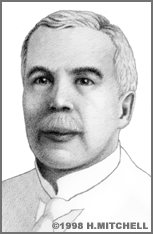Gilbert Lewis
Gilbert Newton Lewis, one of the most influential and admired scientists of the twentieth century, was a pioneer in both chemistry and physics.
Born in Weymouth Landing, Massachusetts in 1875, Lewis was able to read by the age of 3. He entered college at age 15, and then transferred to Harvard University, where he earned a BS (1896) and a PhD (1899). His research concentrated on thermodynamics and valence theory (on the behavior of electrons when atoms combine). From this early work on valence, Lewis developed the concept of the covalent bond and invented the "Lewis symbols," which are still used to describe ways in which atoms bond.
Lewis taught at Harvard and the Massachusetts Institute of Technology before becoming a Professor and Dean at the University of California at Berkeley. He single-handedly transformed the then-languishing College of Chemistry at UC Berkeley into one of the nation's best. Lewis became the mentor to 290 PhD recipients and 20 Nobel Prize winners. He directed the experiments that resulted in the discovery of elements 93-106.
In his own work, Lewis combined strict discipline in collecting and organizing data with innovative interpretation of the results. In the early 1930s, he became the first scientist to produce "heavy water" with double-weight hydrogen atoms, which was essential to early experiments in atomic energy. He also worked with Ernest Lawrence on the invention of the cyclotron and in early atom-smashing experiments. Lewis focused on photochemistry from the late 1930s until his death in 1946. In fact, it was he who coined the term "photon."
Gilbert Newton Lewis won numerous honors for his work, including the Society of Arts and Sciences Medal as "the outstanding chemist in America" (1930). He was nominated for the Nobel Prize in chemistry over 30 times, and still today, many scientists believe he well deserved it.


